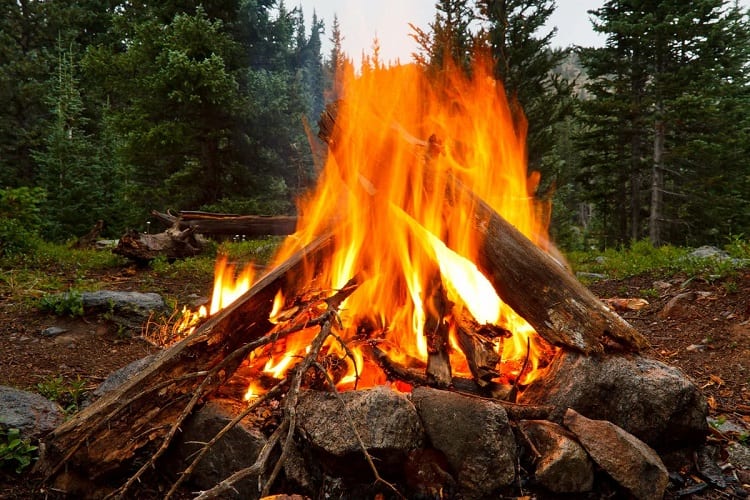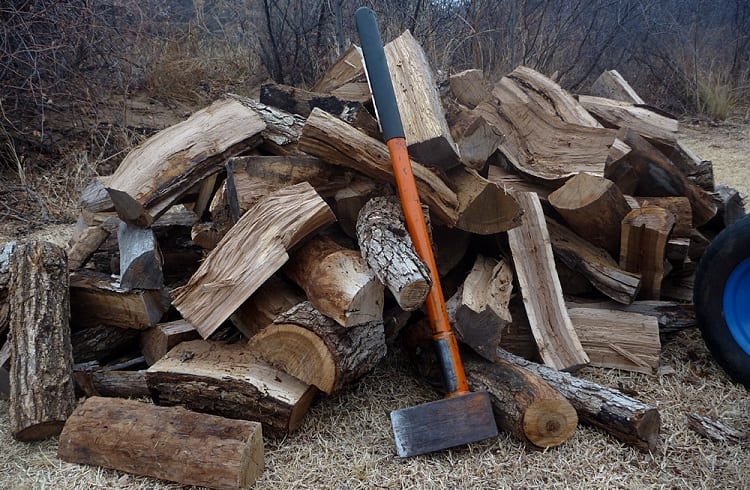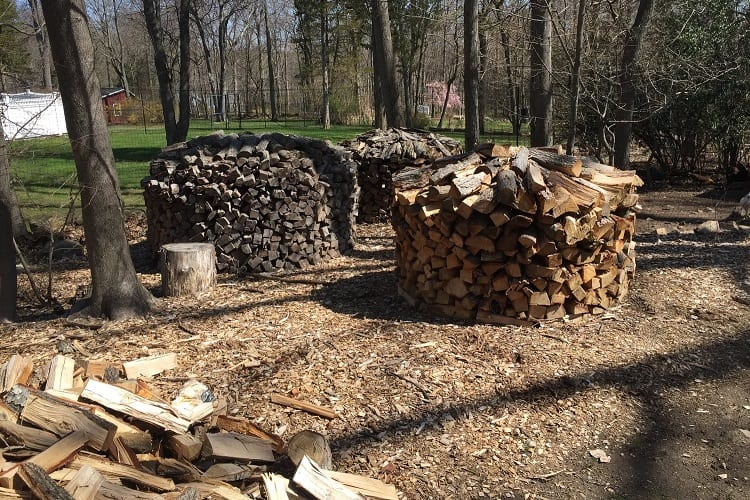Wet firewood is completely useless.
You need your firewood to be bone dry to effectively catch and consistently add to your campfire and flame, otherwise you’re just up the creek with no paddle in sight.
But what happens if it rains and floods the area?
If your firewood is left out and doesn’t have a nice dry side to work with, you run into problems. Your fire is going to be weak even if you do get it going.
You’re left with one option: manually drying it out to the best of your abilities. This is how to dry firewood fast.
Is There A Way To Dry Firewood Fast?

Wood is a naturally occuring polymer. Most natural polymers contain some level of moisture, and wood is no different.
The ideal moisture in wood used in construction is between 7% and 11%, and if you’ve ever touched a piece of cured plywood during a renovation or construction project, you might be thinking “How does that dry-as-sand wood have any moisture to it?”
Moisture is deep-seated in wood and locked in. Without any moisture, wood would become brittle and break apart. I mention all of this to show the contrast between what we assume is dry wood, and dry firewood.
The drier something is, the better it burns. When you burn wet firewood, energy is first being converted into boiling the moisture trapped inside of wood fibers. The higher the moisture content, the longer it will take to burn (or sometimes it might not burn at all).
Now, when you burn wet firewood, you’re still expending heat energy that the wood could be giving off. The common misconception is that burning wet firewood, because it takes longer to actually burn, means more heat and more efficient use of energy. This is incorrect.
You get more BTUs of heat at a faster pace with dry firewood. Otherwise, energy first boils water while burning some of the wood at a lower temperature, and when the wood dries out and begins to burn, you have less of it to burn at that higher temperature. In short, you’re trying to burn wood, not boil it.
What Happens When You Burn Wet Wood?
It may not burn at all, first of all. Depending on how wet the wood is, you’re not going to get any fire. You’ll just waste combustibles and fluid trying to get it to light. This is what’s really happening when you burn wet firewood.
You Create 3x to 4x More Byproducts
Nobody is standing over a campfire just inhaling chemicals that come off of wood and tinder, but if you burn wet firewood, you’re getting those byproducts anyway.
Regardless of whether it’s natural wood from the forest floor or a Duraflame log, you’re producing more creosote, which can seriously damage the damper in your chimney or create unnecessary buildup in a wood-burning stove.
Not to mention the negative health implications of being around that.
More Black Smoke
When wood burns less efficiently, there’s more black smoke. This site is centered around prepping, and in an SHTF situation, you want your campfire to be as inconspicuous as possible.
That means minimal black smoke so you don’t give away your position. The increased black smoke is also indicative of the byproducts in the air, which is bad for your health.
Shorter Fires
As energy is converting to boiling water in wet wood, it’s also being wasted.
Your fire is going to last for less time, and burn at a lower heat.
Louder Fire
We can all picture the sound of a cackling fire in our minds right now, but when firewood is wet, it’s louder.
The moisture burns off and produces loud snaps and cackles in the fire. This is different from a dry fire, although not necessarily the worst thing in the world.
Splitting Firewood is Essential to Water Evaporation

Wet wood is easier to split than dry wood. That being said, you need to split wet wood to get it to dry faster. It dries it out, but it also optimizes each piece of wood for burning. There’s a reason that we’ve been doing it for so long.
When you split wood, you increase the surface area of the wood fibers and decrease the available surface area of the bark. Bark can still burn, but it’s much harder to burn than wood fiber, or the inside of the tree/log.
The dry, fibrous sides catch fire and eventually the bark does. It makes wood more optimal for ignition, but also, the overall surface space of that piece of wood has increased with a smaller mass, requiring less time for moisture to evaporate through the fibers.
The larger the wood, the longer it takes for moisture to evaporate from it. Moisture has to travel up through the fibers of the wood to reach wherever the surface is, so by reducing the mass of each piece of wood (cutting it up), you speed up the process.
Methods to Dry Firewood Fast

We’re trying to dry it faster now that we know why it’s important for your firewood to be dry.
These are the two most common drying methods available.
Stacking
We’ve seen this in movies, TV, and at locations that sell fresh firewood. Stacking up pieces of freshly split firewood is helpful so long as you have the ends sticking out to receive air exposure.
Because firewood can take so long to dry out, this is an effective way to store it while drying it, although it might not be the fastest method (depending on the season and where you live) You should have some form of a tarp as a roof over these pieces to ensure rain doesn’t ruin them.
Sun Exposure
This can be a little riskier, because this involves placing some tarps on the ground and then laying out each piece of wood, bark down, allowing it to get immediate sun and air exposure.
On breezy days, you can expect your wood drying process to kick into high gear. If it starts raining, of course, you’ll have to rolls the tarp up and place it somewhere else until the torrent stops.
This is riskier because you have to manually move the wood, but with proper stacking, it’s a set and forget method.
How to Tell if Your Firewood is Ready

Apart from just splitting it and being able to tell when it’s dry, there are some other factors that you have to keep in mind.
- Moisture Gauge: This handy little device can be used to directly and effectively test the moisture content inside of a piece of wood. You can get them from most hardware stores. Simply stick the prongs into the wood and you’ll get a percentage reading. You want between 10% and 20% for your firewood if you can help it, although drier is always better.
- Aroma: Does your wood smell more like the forest than just wood? Look for green in the wood. This has to be left to cure on its own, because what you’re looking at is sap. It will eventually fade into the wood and give off a nice woodsy aroma.
- Burn Test: Your logs are split, and they feel dry. Chip off a small piece from the closest point to the wood’s center as possible, and try to burn it. You can use something simple like a lighter, you just want to see if it’s going to burn and how long it’s going to take before it does.
- Test the Weight: This isn’t a surefire way to tell, but since wood does get lighter as moisture evaporates, pick up a piece of split firewood. Does it feel lighter than usual? This is a good indicator that you can use a moisture gauge to check.
- Loose Bark: While also not a clear indicator, dry wood does begin to shed its bark. Looser bark means the wood could be drying inside, though it still might not be ready to burn at this point.
- Color: Greens fade over time and you get that tan-ish wooden color that we all know. Coloration will change, but not all at once. Wait until all the green is gone before you decide to start burning your firewood.
Drier Firewood is Better
Wet firewood is a no-go. It can be bad for your health, for keeping a low profile in a SHTF situation, and above all else it’s a waste of energy for a would-be perfect fire. The drier, the better.
Stacking, ashing, and even manually drying wood out to the best of your abilities; you have options, even if they aren’t ideal, that will speed up the process. You should never burn wet firewood (good luck if you try), and with this quick little guide, you won’t have to.


[lasso rel="emergency-preparedness-more-a-manual-on-food-storage-and-survival-2nd-edition-revised-and-updated" id="35334"]